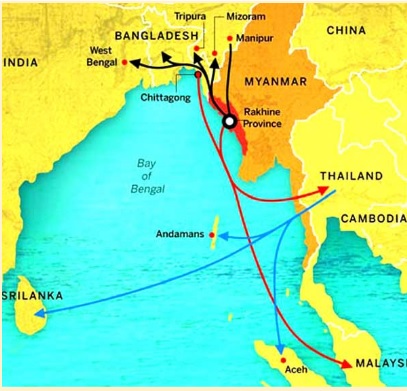Civil War in Myanmar | 23 Nov 2023
For Prelims: Civil War in Myanmar, Foreigners Act of 1946, Refugees.
For Mains: Civil War in Myanmar, Security challenges and their management in border areas.
Why in News?
Recently, due to the ongoing Civil War in Myanmar, 1,500 nationals of Myanmar took refuge in Mizoram’s Champhai district following an intense gunfight between the Myanmar Army, and pro-democracy militias in the country’s western Chin State abutting Mizoram.
What is a Civil War?
- A civil war is a prolonged conflict between organized groups within the same country or nation.
- It involves armed confrontations between factions or groups with distinct social, political, or ideological differences, all vying for control or dominance over the nation's governance, territory, or resources.
What is Background of the Current Civil War in Myanmar?
- 2020 Elections and Military Coup:
- In the November 2020 elections, Aung San Suu Kyi's party National League for Democracy (NLD) won the election. However, the military junta, known as the Tatmadaw, claimed electoral fraud without substantial evidence and rejected the election results.
- In February, 2021, the military staged a coup, detaining Aung San Suu Kyi and other elected leaders, declaring a state of emergency, and seizing control of the government.
- Protests and Resistance:
- The coup triggered widespread protests across Myanmar, with citizens demanding the restoration of democracy and the release of detained leaders.
- Civil servants, activists, and various groups joined the civil disobedience movement, staging strikes and demonstrations.
- Formation of Resistance Forces:
- As the Tatmadaw intensified its crackdown on dissent, opposition groups, including Ethnic Armed Organizations (EAOs) and armed civilians, formed the People's Defence Forces (PDFs) to resist the military junta.
- These groups aligned themselves with the National Unity Government (NUG), established by ousted lawmakers, aiming to challenge the military's authority.
- Current Scenario:
- Fighting has also broken out elsewhere in the country, led by various local resistance forces — in the Rakhine State, Kayin State, Sagaing region bordering Manipur, and Chin State bordering Mizoram.
What does Ongoing Civil War in Myanmar Mean for India?
- Balanced Stance:
- India has so far walked a fine line between expressing concern at the “interruption” of democracy in Myanmar, and engaging with the junta to protect its “vital interests”.
- Immediate Concern for India:
- The influx of Myanmarese nationals in the border states of the Northeast.
- This too at a time when the situation in Manipur remains volatile.
- Capturing of Two Important Towns by Rebels:
- The anti-junta forces have captured two important towns close to the only two border crossing points between Myanmar and India. These are:
- Rikhawdar, close to Zokhawthar in Mizoram, and
- Khampat in Sagaing region, around 60 km from Moreh in Manipur.
- The latter (Khampat in Sagaing region) is also part of the proposed India-Myanmar-Thailand trilateral highway project.
- The anti-junta forces have captured two important towns close to the only two border crossing points between Myanmar and India. These are:
What is the Current Legislative Framework in India to Handle Refugees?
- India treats all foreigners whether illegal immigrants, refugees/asylum seekers or those overstaying visa permits under
- Foreigners Act of 1946: Under Section 3, the central government is empowered to detect, detain and deport illegal foreign nationals.
- Passport (Entry into India) Act, 1920: Under Section 5, authorities can remove an illegal foreigner by force under Article 258(1) of the Constitution of India.
- Registration of Foreigners Act of 1939: Under this, there is a mandatory requirement under which all foreign nationals (excluding overseas citizens of India) visiting India on a long-term visa (more than 180 days) are required to register themselves with a Registration Officer within 14 days of arriving in India.
- Citizenship Act, 1955: It provided provisions for renunciation, termination, and deprivation of citizenship.
- Further, Citizenship Amendment Act, 2019 (CAA) seeks to provide citizenship to Hindu, Christian, Jain, Parsi, Sikh, and Buddhist immigrants persecuted in Bangladesh, Pakistan, and Afghanistan.
- India issued a Standard Operating Procedure (SOP) to be followed by all concerned agencies while dealing with foreign nationals who claim to be refugees.
UPSC Civil Services Examination, Previous Year Question (PYQ)
Prelims
Q. Consider the following pairs: (2016)
| Community sometimes mentioned in the news | In the affairs of | |
| 1. | Kurd | Bangladesh |
| 2. | Madhesi | Nepal |
| 3. | Rohingya | Myanmar |
Which of the pairs given above is/are correctly matched?
(a) 1 and 2
(b) 2 only
(c) 2 and 3
(d) 3 only
Ans- (c)
Mains
Q. How does illegal transborder migration pose a threat to India’s security? Discuss the strategies to curb this, bringing out the factors which give impetus to such migration. (2014)

